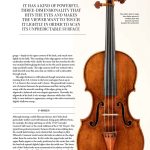The Strad magazine, October 2004 issue: A fitting conclusion
Copyright © 2004 Alberto Giordano – The Strad magazine. All rights reserved
The City of Genova came into the posession of the violin of Paganini on the 4th of july of 1851, eleven years after the death of the great virtouso: following the records of the consignment the son of Niccolò Paganini, Baron Achille opened the closet in which the violin was sealed, in the presence of various witnesses in the mansion of signor Luigi Bartolomeo Migone.
A banker and an assessor for the municipality as well, Migone was and an old friend of Paganini, a very respected man in Genova who was encharged to preserve the violin until the consignment to the major.
The donation was delayed for several reasons: the Town Hall was settled in its definitive site, the Palazzo Tursi building in the late forties, and it seems that it was difficoult to find a convenient place where to place the violin; on the other side, Baron Achille was not so eager to consign the precious violin for almost understandable reasons. Achille Paganini opened the red leather case embroyded with gold and showed the violin to the congregation for its final identification: besides the Cannon (and the case as well), the City of Genova aquired two violin bows, a package of strings and a new box of rosin from the workshop of J.B.Vuillaume. The violin was exhibited only eight years later, when it was placed together with one bow of the two in a glass bell near the marble bust of King Carlo Alberto and some letters from Cristoforo Colombo: the case with the remaining contents was put aside and correctly registred in the various properties of the town.
The picture aside (1), although difficult to date, is probably one of the first portraying the Cannon and shows the violin in the same condition as left by Paganini. In the following image (2) published in 1909, we see that the bridge had already been substituted. The Cannon remained untouched until 1937, when Cesare Candi was encharged for a restoration work: he opened the violin (the glue was probably weak in spots), he consolidated the linings, the blocks and the neck setting and he made a new bridge. He had a great respect for the original fittings: he didn’t changed the old short fingerboard and he did a spiral bushing work in the pegholes in order to mantain the pegs used by Paganini. The violin lost those accessories later on: the records found are not clear, since it is difficult to argue if the fingerboard and the tailpiece were put aside by Giuseppe Lecchi in the mid fifties or by Lorenzo Bellafontana in the late sixties.
Anyway, it was decided to make a new fingerboard and a maple shim just to reach a playable neck projection. The pegs were substituted before by Bellafontana, later by Renato Scrollavezza in 1991: they both decided for german made ‘boxwood’ pegs, in the Hill style. Pegs, tailpiece and fingerboard didn’t join the rest of the Paganini’s set in the archives of the Palazzo Rosso museum: they were recently found in a different location and they were fortunately in very good state of preservation.
It’s intriguing how fittings can affect the image of a violin: they are traditionally considered accessories, movable parts separated from the rest and for that reason the integrity of historic instruments were irrrimediately damaged. Fingerboard, tailpiece and pegs in this case didn’t come from Giuseppe Guarneri del Gesù’s workshop but they were chosen and used by Paganini: their importance is not only aesthetical but functional as well.
Pegs and button (3) – Made of rosewood, they appear to be of french origin: it is possible that they were substituted by Vuillaume in 1834 when he took on the restoration of the violin. This is a very simple style peg, with no decoration: we may argue that Paganini prefered not to enrich the image of the violin with a sophisticated set of pegs.
Tailpiece (4) – Made of ebony, again appear to be of french make. It is 135mm long: a quite long tailpiece if we consider that the Cannon is not a long violin (354mm the front) with a long stop (198mm): the length of the string between tailpiece and bridge was in that way reduced to about 48mm.
Fingerboard (5) – It was made by the polish violinmaker Nikolaus Sawicki in Wien in 1828 – ebony wood, signed on the back ‘Nicolo Sawicki fece 1828’ (6).
The particularity of this fingerboard is in the wedge shape of the profile (7): this is necessary in order to reach a playable neck projection, since the neck of the Cannon is set nearly square to the block (88°) and the overstand from the purfling about 4.5mm only.
The upper curve was probably planed by Candi in 1937: though that operation canceled the evidence of the use of Paganini, on the other side Candi didn’t make a new modern shape, he passed on the old curve with the plane leaving some evidence of the curve used by Paganini. It is possible to understand that the upper portion was much rounder than the modern standard curve while the lower portion (that nearest the bridge) was considerably flatter: no evidence is left as regards the airspace needed under the string lenght. A few considerations regarding the nut: the one used by Paganini was probably lost during the last substitution of the fingerboard, but if we examine the picture (1) we may deduce that the string spacing was quite wide, somewhat around 20mm.
Finally the length of the fingerboard: it is 262mm, a typical nineteenth century length: the highest treble notes were played beyond its end.
What is extremely difficult to examine is when the neck of the violin was reset and by whom, since there is no evidence that Sawicky did that.
Bridge (8) – A tiny maple bridge of uncertain origin. The impression is that it is a transition bridge but there is the possibility that it can be older. Eighteenth century instruments in original condition are now extremely rare and it is quite difficult today to attribute an exact date to a spare bridge. According to the information we can get from the collection of bridges coming from the Museé of the Conservatoire in Paris it seems anyway that this kind of model was quite in fashion in northern Italy during the second half of eighteenth century: some of them bear written tags indicating their supposed attribution (Bellosio, Deconet etc.). One of them is particularly intrigueing since it bears a label ‘Guarnerius del Gesù’ (9) and it is very close to the one left by Paganini: that bridge was aquired by the parisian museum in 1880 from a private collection and for that reason there is no evidence about the attribution to Giuseppe del Gesù, we can only decide to trust or not the written tag. In any case it is true that Niccolò Paganini relied so much on that bridge since it remained on the instrument after a neck resetting and after a fingerboard substitution. The bridge shows very small feet (7.8*3.6mm) with a quite narrow spread (38mm) and an almost flat curve with wide string spacing (35mm). The small hole at the bottom is pierced on both sides of the bridge but it doesn’t pass through. Strings (10) – E,A,D plain gut strings in an envelope sealed with the arms of Genova. Italian string manufacturer and researcher Mimmo Peruffo analyzed the structure of the strings: the E string is 0.70/0.72mm thick, medium twist – the A string 0.87/0.89 high twist – the D string 1.15/1.16 high twist. No G string was left, but from the deep notch on the bridge we can deduce it was wired, the diameter around 1.35. From the correspondence of Paganini we know he bought the strings in Naples and he asked for thin treble strings ‘made of four strands to endure’. It is difficoult to get a thin violin string from a four strand joint, there is the possibility that he was asking in that letter for guitar strings, or maybe the term ‘thin’ must be interpretated in a different way from the modern: it is anyway evident that the strings left together with the violin are quite thick and rigid.
The Strad, october 2004




